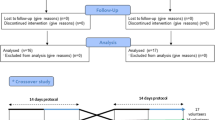Abstract
Objectives
Iatrogenic infections are serious problems in dental offices. Impression tray adhesives are delivered in glass containers with a fixed brush attached inside the cap. Using the brush for application of the impression tray adhesive on a contaminated impression tray or prostheses, pathogen transmission by replacing the cap with the brush is possible.
Materials and methods
Bacterial strains (patient strains and in vitro strains) were supervaccinated on Columbia agar. The bacterial solution was diluted with TSB and aerobically grown, and starting concentration was 1 × 107 cfu/ml. The stock solution was placed on Columbia agar. Alginate, polyether, and silicon impression tray adhesives were applied to the center of the particular blood agar plates and incubated for 48 h. The expansion of the inhibition zone assays were measured using a microscope.
Results
Twenty-one different bacterial strains were selected in the saliva samples of 20 patients. The growth inhibition for alginate impression tray adhesive was 1.1 % (±0.3) of the patient strains. The overgrowth of polyether impression tray adhesive was 30.6 % (±9.3) and for silicon impression tray adhesive 11.8 % (±5.0). In in vitro strains, alginate impression tray adhesive performed an inhibition of 0.7 % (±0.3). The overgrowth of polyether impression tray adhesive was 7.0 % (±1.6) and for silicon impression tray adhesive was 6.5 % (±1.3).
Conclusions
Using the fixed brush for application of the impression tray adhesive on multiple patients, a cross-contamination cannot be ruled out.
Clinical relevance
An application of the impression tray adhesive with a pipette and a single-use brush would eliminate the contamination.



Similar content being viewed by others
References
Rubino S, Cappuccinelli P, Kelvin DJ (2011) Escherichia coli (STEC) serotype O104 outbreak causing haemolytic syndrome (HUS) in Germany and France. J Infect Dev Ctries 5:437–440
Carlet J, Astagneau P, Brun-Buisson C, Coignard B, Salomon V, Tran B et al (2009) French national program for prevention of healthcare-associated infections and antimicrobial resistance, 1992–2008: positive trends, but perseverance needed. Infect Control Hosp Epidemiol 30:737–745
Cristina ML, Spagnolo AM, Sartini M, Dallera M, Ottria G, Perdelli F et al (2009) Investigation of organizational and hygiene features in dentistry: a pilot study. J Prev Med Hyg 50:175–180
Gyorfi A, Fazekas A (2007) Significance of infection control in dentistry: a review. Fogorv Sz 100:141–152
Szymanska J (2005) Microbiological risk factors in dentistry. Current status of knowledge. Ann Agric Environ Med 12:157–163
Araujo MW, Andreana S (2002) Risk and prevention of transmission of infectious diseases in dentistry. Quintessence Int 33:376–382
Abe S, Ishihara K, Okuda K (2001) Prevalence of potential respiratory pathogens in the mouths of elderly patients and effects of professional oral care. Arch Gerontol Geriatr 32:45–55
Bergmann-Krauss B, Micheelis W, Szecsenyi J (2010) Acceptance of dental care guidelines by quality circles. Z Evid Fortbild Qual Gesundhwes 104:599–604
White JT, Jordan RD (1987) Infection control during elastomeric impressions. J Prosthet Dent 58:711–712
Puttaiah R, Cederberg R, Youngblood D (2006) A pragmatic approach towards singleuse-disposable devices in dentistry. Bull Group Int Rech Sci Stomatol Odontol 47:18–26
Herman DA (1993) A study of the antimicrobial properties of impression tray adhesives. J Prosthet Dent 69:102–105
Lewis T, Patel V, Ismail A, Fraise A (2009) Sterilisation, disinfection and cleaning of theatre equipment: do we need to extend the Spaulding classification? J Hosp Infect 72:361–363
Kohn WG, Harte JA, Malvitz DM, Collins AS, Cleveland JL, Eklund KJ (2004) Guidelines for infection control in dental health care settings—2003. J Am Dent Assoc 135:33–47
Smith AJ, Bagg J, Hurrell D, McHugh S (2007) Sterilization of re-usable instruments in general dental practice. Br Dent J 203:E16
Chai JY, Jameson LM, Moser JB, Hesby RA (1991) Adhesive properties of several impression material systems: part II. J Prosthet Dent 66:287–292
Dethlefsen L, Fall-Ngai M, Relman DA (2007) An ecological and evolutionary perspective on human–microbe mutualism and disease. Nature 449:811–818
Zaura E, Keijser BJ, Huse SM, Crielaard W (2009) Defining the healthy “core microbiome” of oral microbial communities. BMC Microbiol 9:259
Rozkiewicz D, Daniluk T, Zaremba ML, Cylwik-Rokicka D, Luczaj-Cepowicz E, Milewska R et al (2006) Bacterial composition in the supragingival plaques of children with and without dental caries. Adv Med Sci 51(Suppl 1):182–186
Sbordone L, Bortolaia C (2003) Oral microbial biofilms and plaque-related diseases: microbial communities and their role in the shift from oral health to disease. Clin Oral Investig 7:181–188
Kuramitsu HK, He X, Lux R, Anderson MH, Shi W (2007) Interspecies interactions within oral microbial communities. Microbiol Mol Biol Rev 71:653–670
Nasidze I, Li J, Quinque D, Tang K, Stoneking M (2009) Global diversity in the human salivary microbiome. Genome Res 19:636–643
Stevens DL (1992) Invasive group A streptococcus infections. Clin Infect Dis 14:2–11
Acknowledgments
The authors thank Biologist Astrid Heidrich from Perth/Australia for her technical support and for her comments of the manuscript.
Conflict of interest
The authors declare that they have no conflict of interest.
Author information
Authors and Affiliations
Corresponding author
Rights and permissions
About this article
Cite this article
Bensel, T., Pollak, R., Stimmelmayr, M. et al. Disinfection effect of dental impression tray adhesives. Clin Oral Invest 17, 497–502 (2013). https://doi.org/10.1007/s00784-012-0735-z
Received:
Accepted:
Published:
Issue Date:
DOI: https://doi.org/10.1007/s00784-012-0735-z




